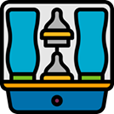A baby’s immune system is not as developed as an adult’s. Sterilising all feeding equipment helps to protect your baby against illnesses & infections.
 It is recommended that all equipment used for collecting and storing formula milk is sterilised before use.
It is recommended that all equipment used for collecting and storing formula milk is sterilised before use.
You might not think it but milk provides an ideal breeding ground for bacteria that could give your baby an infection. Sterilising gets rid of any nasty bacteria that could cause harm to your baby.
Different Ways To Sterilise
There are several ways you can sterilise your baby's bottles. Methods you can choose are:
Remember to use a set of kitchen tongs when handling sterilised items to keep them as clean as possible.
Warning - If using boiling water to sterilise your baby's feeding equipment please be very careful and do not have your baby near the saucepan at any time.
To sterilise your baby's bottle in cold water sterilising solution always follow the manufacturers instructions. It's important to follow these as there are several different types of sterilisers.
Cold Water Sterilising Solution
To sterilise your baby's bottle in cold water sterilising solution always follow the manufacturers instructions.
What To Do After Sterilising
Once you have sterilised your babies feeding equipment you should:
It is important that you do not contaminate the equipment after it has been sterilised. If this happens, sterilise the equipment again!
When Can I Stop Sterilising?
It is recommended to sterilise all feeding equipment each time you use it, for at least the first 12 months of your baby’s life.
If your baby is less than 28 days old you can contact your local midwifery team or you can contact the Healthy Child Programme at any time following your baby's birth by calling Just One Number on 0300 300 0123 or texting Parentline on 07520 631590.
Our opening hours are 8am-6pm Monday to Friday (excluding bank holidays) and 9am-1pm on Saturdays.
Norfolk Healthy Child Programme has a team of infant feeding champions who can contact you by video call/telephone initially to discuss your questions and refer you to further help if required. All of our staff are trained to Unicef standards to provide you with the best possible breastfeeding support and advice.
It may help in the first instance to read the Essential Guide to Feeding & Caring for your Baby.
Norfolk’s Early Childhood and Family Service (ECFS) offers support for all parents and carers with children aged 0 to 5 years.
To speak to other Norfolk parents and carers, you can join our online community forum below.
Also in this section...